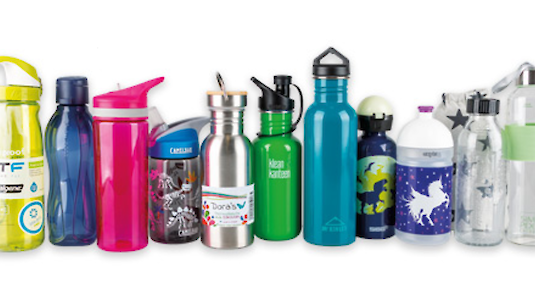KONSUMENT Drinking bottle test
In cooperation with the Arbeiterkammer Steiermark, the VKI tested eleven returnable drinking bottles. The focus of the drinking bottle test, in which bottles between 400 and 750ml made of plastic, metal and glass were tested, was on practical suitability and freedom from harmful substances.
Pollutants are not necessary
The chemical test gave a very reassuring result for the majority of the bottles. Three bottles were found to contain harmful substances - one of which contained small amounts of a plasticizer that is considered harmless. However, there was no evidence of the use of plasticizers in other drinking bottles. Harmful silicone components were also detected, but - with one exception - these were below the permitted limit.
Practically good
In daily use, a drinking bottle should prove its worth several times over: ideally, it should be tight, easy to handle and clean (preferably in a dishwasher), stand up well, withstand falls and not change the taste of the liquid it contains. The test in this respect produced a positive result. Three times a "very good" was awarded in this area, otherwise all were "good". Only one bottle received an "average" because it showed weaknesses in terms of changes in taste and smell and in the drop test. Due to the fall the closure opened and was no longer tight afterwards.
Why no PET?
Water from PET bottles always contained microplastics in recent studies. In general, disposable bottles are not designed for refilling. They only need to be able to retain their contents until the best before date is reached. If a disposable bottle is refilled, microparticles can be released again due to mechanical stress such as filling, shaking or buckling. The material is also attacked by (carbonated) acidic drinks, which can also cause acetaldehyde to dissolve: a substance suspected of being carcinogenic.
The perfect bottle
Glass and metal bottles are generally neutral in taste, but they suffer from greater stress (risk of breakage, dents). Transparent bottles allow the fill level and contamination to be easily detected. Plastic bottles are light - but often susceptible to changes in taste and smell. The silicone content of drinking bottles should be low - because of possible pollutants. Large filling openings facilitate cleaning and pouring, small openings and mouthpieces avoid spillage.
Conclusion: "the" bottle does not exist - the most suitable bottle for you is best found by trying it out in a shop. Or by reading the KONSUMENT test in detail in the test magazine KONSUMENT (for a fee).
You can also find the test results at our cooperation partner AK Steiermark.
